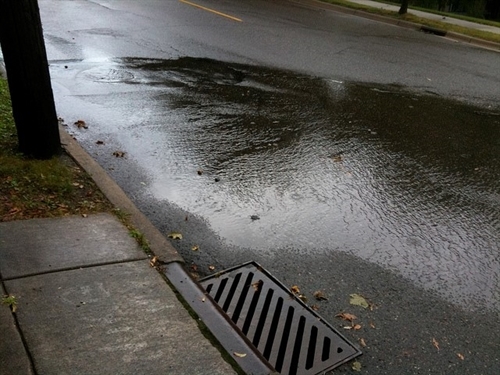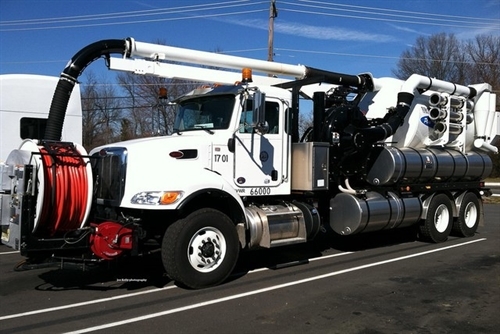Improving a community's stormwater system doesn't always require expensive upgrades. A Village of Westchester Public Works Director explains how cleaning catch basins is an inexpensive and vital improvement.

Cleaning stormwater catch basins helps prevent flooding
 By Robert S. Lewis, Public Works Director, Village of Westchester, IL
By Robert S. Lewis, Public Works Director, Village of Westchester, IL - March 19, 2018
Tweet this

Village of Westchester Department of Public Works
Stormwater generally enters the drainage system through street inlets and catch basins
Municipalities construct and maintain a network of storm sewers and sewer inlets to collect and convey rainwater that falls on roads and parking lots and other land surfaces. Stormwater collection and conveyance systems help protect streets and property from flooding, and help protect local water resources by capturing pollutants to prevent them from reaching lakes, rivers, streams, wetlands and other waters where they could have a negative effect on water quality, aquatic animals or human health. Constructing stormwater infrastructure is a major financial investment for towns and cities, and we want to get maximum value for these investments. One thing we can do to maximize the performance of stormwater infrastructure is to perform regular maintenance. This article addresses the benefits of systematic maintenance programs, including in particular sewer cleaning and regular catch basin cleaning.
In an urban street drainage system, a critical pollutant defense mechanism is the catch basin. The purpose of a catch basin is to capture debris, separating it from the water flowing to the sewers.
As rainwater falls and runs across streets and sidewalks and parking areas, it picks up pollutants such as gasoline, oil, road salt and fertilizer, along with other debris. Instead of filtering into the soil, the rainwater flows into catch basins, through storm sewers, and out to nearby bodies of water, carrying many of the pollutants with it. Removal of debris and smaller particulate matter in the sewer network is important to prevent this material from clogging the stormwater management system and washing into receiving waterways. One thing communities can do to pick up pollutants and debris is provide for periodic street-sweeping. In addition to helping perk up the visual appearance of the street, sweeping picks up grit and litter and pollutants that would have washed into the storm sewer system during the next rain event. Street-sweeping is a valuable component of stormwater maintenance efforts, but it only one part of the stormwater regime.

Village of Westchester Department of Public Works
A new catch basin being installed
In general, the greater the traffic on a roadway and number of vehicles using a parking area, the greater the pollutant loads. In an urban street drainage system, a critical pollutant defense mechanism is the catch basin. The purpose of a catch basin is to capture debris, separating it from the water flowing to the sewers. A catch basin is a form of grit chamber intended to retain heavy particulate debris in stormwater flows and prevent the sediment from flowing into the sewers, and then into streams and lakes. Catch basins have been around for a while, they were first used in 1880's. Of course designs have improved greatly over time. The scheduled cleaning of catch basins is critical to keep these devices operational. It is also a substantial maintenance operation to service catch basins. As an example an urban town of about 20,000 people might have around 60 miles of streets with over 2,000 catch basins. All need to be cleaned and maintained in intervals between storms, with seasonal demands like spring and fall months that required increased cleanings to keep up with debris from trees.
Frequent cleanings of catch basins keeps drainage infrastructure open and functioning well, thus reducing the occurrence of street flooding and potential sewer backups.
A couple special dimensions of catch basin maintenance. One thing to keep in mind is proper disposal of the debris. The material cleaned out of catch basins is a messy mix of dirt, rocks, litter and small amounts of pollutants such as oil and grease and fertilizers. The material removed from the catch basins must be properly disposed of, usually in a State-approved landfill. Another factor that can be important is during warmer months, the retained water in a catch basin may cause odor or mosquito nuisance conditions. Bio-degradable chemicals and targeted insecticides (e.g., a slow release mosquito growth inhibitor that prevents adult mosquitoes in small bodies of water like catch basins) can be used to help prevent nuisance conditions. There are products reviewed and approved by the EPA and do not cause downstream harm to the aquatic environment.

Village of Westchester Department of Public Works
Sewer vacuum cleaning truck
Our experience in Westchester is that frequent cleanings of catch basins keeps drainage infrastructure open and functioning well, thus reducing the occurrence of street flooding and potential sewer backups. Even in smaller rain events the reduction of localized street flooding reduces the hazards to the motoring public. Maintenance crews often target busier street with more frequent cleaning to reduce these potential hazards. Where these systems fail is when no maintenance is done or deferred to the point where the device is ineffective.
A third component of an effective maintenance program is cleaning the stormwater sewers themselves. Even with street sweeping and with a good network of catch basins, material can accumulate in the storm sewers. And if a great deal of material builds up, the performance of the sewers diminishes. Keeping the sewers cleaned of debris allows maximum use of the hydraulic capacity and conveyance of the existing pipe—a pipe half full of debris only has half of the capacity to convey water. In Westchester we typically clean sewers year round, with the exception of when temperatures below freezing Overloaded pipes back up and may cause flooding into homes and commercial structures. Everyone benefits from clean pipes and we experience fewer backups, reduced street flooding and fewer impacts on the properties in our Village.